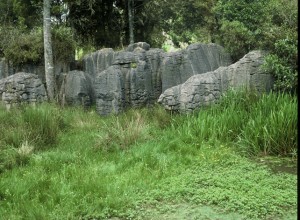The hill country of the Western Waikato is home to many karst ecosystems and landscapes. These karst landscapes are formed when water dissolves carbonate-containing rocks such as limestone.
They are scattered from Port Waikato to Mokau and include the glowworm caves at Waitomo and a variety of sculpted pools, caves, arches, gorges, disappearing streams, springs and unusual rock formations. This geodiversity creates some unique ecosystems and species.
There are particular plant species found only on limestone outcrops or in cave entrances such as Hebe scopulorum which is confined to exposed limestone bluffs south of Kawhia Harbour; and Asplenium cimmeriorum which is found in cave entrances; while many other plants have strongholds on the limestone such as the spleenwort fern Asplenium lyallii and the climbing rata Metrosideros colensoi.
Eyeless cave beetles and other species are found deep in the caves while cave weta prefer the cave entrances.
Glowworms need a steady supply of flying food to get caught in their sticky ‘fishing lines’, a humid habitat – hence they prefer living in moist caves, along stream banks and in tunnels; and a still atmosphere -so their lines don’t get tangled. Bats seem to favour the karst landscapes which provide a range of roosting and breeding sites.
Even native fish have been found in cave streams and recently several new species of springs snails with very limited distribution have been found in Waikato karst areas.


